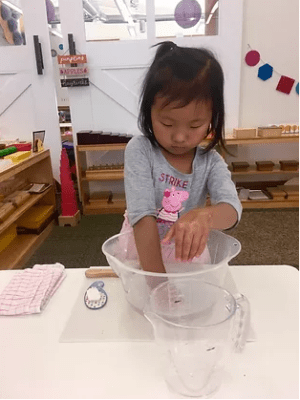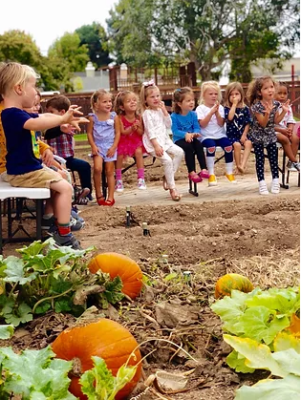It’s that time of year again where you can hear sniffles and coughs in between holiday singing and sleigh rides. We all can’t wait for the holidays, a time when we can visit with friends and relatives, but we don’t want germs to visit along the way! How can we decrease the spread of disease in our homes and classrooms?
Why Wash our Hands?
According to the CDC, clean hands are one of the most important ways to avoid getting sick, particularly because they reduce the spread of germs. For example, microscopic bugs can remain on the hands after using the bathroom, touching objects from another person who left germs on it, or even after handling raw meat. Germs can be easily passed from person to person, causing everyone to get sick. Think about it; there are many times throughout the day where you unknowingly touch your mouth, eyes and nose and silently allow germs to enter your body. Children’s immune systems are still developing during the preschool years, making children particularly susceptible to germs, especially in shared spaces. Unwashed hands can transfer germs to anything those hands touch, including school materials, handrails, door knobs, and toys! Luckily, the CDC reports that hand washing has multiple benefits, such as:
-
Reducing the number of people who get a diarrheal illness by 23-40%
-
Reducing respiratory illnesses like the common cold by 16-21%
-
Reducing absenteeism due to gastrointestinal illness in school children by 29-57%
One CDC study found that good hand hygiene even correlates with child development. Children whose families received soap to create proper hand washing stations at home experienced about half as much diarrhea in the first 2 ½ years of life compared to the control group which did not have access to soap and water for hand washing. Researchers followed these children for the next few years and found that the children in the hand washing group scored better on developmental testing at 5-7 years old. All of those days of missed school really add up!

Proper Hand Hygiene
Adult caregivers share the responsibility to teach future generations about proper hand hygiene. Clean hands start with you! Another study found that barriers to proper hand washing included a lack of understanding of how, when, and why students should wash their hands. In addition, the study reported poor adult modeling of regular hand washing as an important barrier to proper hand washing in children. At Heritage Montessori, we use the Montessori curriculum to create practical life lessons on proper hand washing. You can reinforce these lessons by continuing them at home and making hand washing part of your daily routine. Remember, hand washing with soap and warm water is the best way to wash and is the only way to stop the spread of viral illness. The best lessons include these important steps:
-
Wet the child’s hands
-
Apply soap to the hands
-
Rub hands vigorously together, scrubbing every surface completely
-
Rub and scrub for 10-15 seconds
-
Rinse completely
-
Dry hands
The best times to wash hands include the following:
-
Upon arrival to the classroom
-
Before and after handling food (including eating)
-
After using the toilet, changing a diaper, or helping a child use the restroom
-
After helping a child wipe his nose or mouth
-
After tending to a cut or sore
-
After outdoor play
-
After administering medication to yourself or a child
-
After handling wastebaskets or garbage
-
After handling a pet or animal
-
After rubbing eyes, nose, putting fingers in mouth, or sneezing

Respiratory Hygiene
Since many illnesses can spread by respiratory droplets, it’s also important to decrease the spread by this route whenever possible! While hand washing is an important factor to decrease the spread of disease, if we can also decrease the secretions in the air, then particles causing disease are less likely to land on objects that act as a vessel to spread disease. Some ways to decrease respiratory droplets in the air include:
-
Instruct the child to cough/sneeze into a tissue or into his or her elbow crease
-
Discourage the child from covering his or her mouth with hands, which can lead to spread of infection by touching other people or materials
-
Instruct the child to throw away tissue immediately after use in the proper waste container
-
As part of our practical life curriculum at Heritage, we teach our students the proper way to blow their nose with Montessori lessons. Continue this at home for the best results and make it a habit!
-
Do not allow children to share eating utensils, cups or towels
Other important tips
A school’s best defense against the spread of germs focuses on two principles: hand washing and exclusion. Parents can help by continuing good hand washing habits at home, but more importantly, by keeping your child home when he or she is sick.
Your child should stay home if he or she has any of the following:
-
Fever (101 degrees or higher; oral/rectal temperatures are most accurate. Remove excess clothing or blankets and retake temperature in 30 minutes to check if it is consistently elevated)
-
Irritable/not acting like his or her usual self with parents, teachers, and other children
-
Tired appearing
-
Persistent cough/runny nose not associated with allergies
-
Eye/ear/nose discharge, particularly if yellow/green in color
-
Red/swollen eyes with or without discharge
-
Vomit
-
Diarrhea
-
Skin rash/skin irritations, especially ones that are open, blistered, or oozing

Final Thoughts
We can all work together to decrease the spread of disease in our community! The best way to do this is through proper hand washing. We hope that your holidays are filled with joy and excitement and not coughs and colds, so let’s keep washing our hands!


